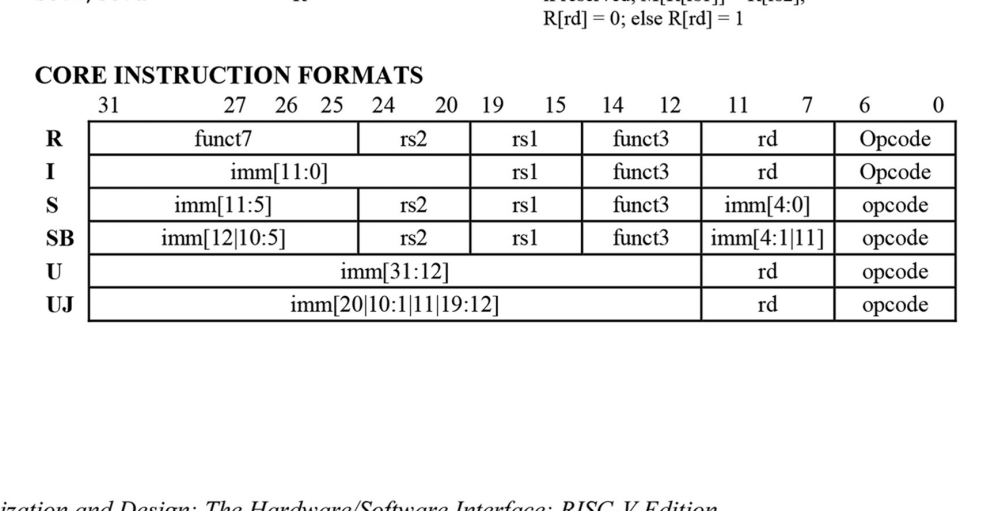RISC-V instructions - advanced
이 포스트는 RISC-V의 Instructions 중 Conditional Operations와 Procedure Call Instructions에 대해 설명한다.
Conditional Operations
만약 조건에 맞으면 지정한 Instruction으로 이동하고 그렇지 않다면 그냥 다음 Instruction 실행.
beq rs1, rs2, L1: rs1 == rs2 이면 L1으로 이동
bne rs1, rs2, L1: rs1 != rs2이면 L1으로 이동
blt rs1, rs2, L1: rs1 < rs2이면 L1으로 이동
bge rs1, rs2, L1: rs1 >= rs2이면 L1으로 이동
ex1)
1
2
if (i==j) f = g+h;
else f = g-h;
1
2
3
4
5
6
7
8
assembly code
//f, g, h in x19, x20, x21
//i, j in x22, x23
bne x22, x23, Else
add x19, x20, x21
beq x0, x0, Exit //unconditional
Else: sub x19, x20, x21
Exit:
bne에서 i==j을 확인하고 같으면 그대로 진행, 다르면 Else로 이동. 그대로 진행 할 때는 Else 부분 코드 실행하면 안되니까 beq 무조건 참으로 만들어서 Exit으로 이동.
ex2)
1
while (save[i]==k) i+=1;
1
2
3
4
5
6
7
8
9
10
11
12
assembly code
//i, k in x22, x24
//address of save in x25
//assume that array save has 8 byte big data type.(ex. long long)
Loop: slli x10, x22, 3
add x10, x10, x25
ld x9, 0(x10)
bne x9, x24, Exit
addi x22, x22, 1
beq x0, x0, Loop
Exit:
한 칸에 8byte니까 i에 8을 곱해주고 그것을 base address에 더해야 save[i]의 주소가 나온다.
ex3)
1
if (a > b) a+=1;
1
2
3
4
5
assembly code
//a, b in x22, x23
bge x23, x22, Exit
addi x22, x22, 1
Exit:
Basic Blocks
branch 없고(마지막 빼고) branch target 없는(처음 빼고) sequence of instructions를 Basic Block이라 한다. 컴파일러는 프로그램을 Basic Blocks로 분해해서 최적화 과정을 진행한다.
Signed vs Unsigned
앞서 배운 blt, bge은 signed comparison을 한다. 하지만 bltu, bgeu는 unsigned comparison을 한다.
x22 = 0xFFFFFFFF
x23 = 0x00000001
signed comparison 이면 x22 = -1, x23 = 1 이라서 x22 < x23이라고 한다.
하지만 unsigned comparison이면 x22 = 4294967295, x23 = 1 이라서 x22 > x23이라고 한다.
Procedure Call Instructions
c언어의 함수를 생각하면 된다.
1
2
3
4
5
6
7
8
9
10
int func()
{
return 1; //procedure return
}
int main(void)
{
int a = func(); //procedure call
return 0;
}
Procedure call: jump and link
1
jal x1, ProcedureLabel1
이 instruction의 다음 instruction의 주소를 x1 register에 저장해두고 ProcedureLabel1으로 jump한다.
Procedure return: jump and link register
1
jalr x0, 0(x1)
return 시키고 x1+0의 주소로 jump한다.
Leaf Procedures
leaf(잎)은 여기서 끝이라는 의미다. 즉 다른 함수를 또 call 하지 않고 값을 return 하는 함수를 가리킨다.
1
2
3
4
5
6
7
8
long long int leaf_example (
long long int g, long long int h, long long int i, long long int j
)
{
lont lont int f;
f = (g + h) - (i + j);
return f;
}
1
2
3
4
5
6
7
8
9
10
11
12
13
14
15
16
17
18
19
assembly code
//g, h, i, j in x10, x11, x12, x13
//f in x20
//x5, x6 temporaries
//need to save original values of x5, x6, x20 on stack
leaf_example:
addi sp, sp, -24 //sp stands for stack pointer, sp == x2
sd x5, 16(sp) //push
sd x6, 8(sp) //push
sd x20, 0(sp) //push
add x5, x10, x11 //x5 = g + h
add x6, x12, x13 //x6 = i + j
sub x20, x5, x6 //f = x5 - x6
addi x10, x20, 0 //copy f to return register
ld x20, 0(sp) //pop
ld x6, 8(sp) //pop
ld x5, 16(sp) //pop
addi sp, sp, 24
jalr x0, 0(x1) //return to caller
 register 하나에 8byte(64bit)라는 가정하에서 register 3개 저장해야하니 24를 내리는거다.
register 하나에 8byte(64bit)라는 가정하에서 register 3개 저장해야하니 24를 내리는거다.
Register Usage
register 마다 각각 쓰임이 있다. 이것은 대부분 지키는 관용적인 것이다.
- x5~x7, x28~x31: temporary registers 이것들은 stack에 굳이 넣어서 저장했다가 pop하지 않고 그냥 덮어써도 되는 register이다.
- x8, x9, x18~x27: saved registers 이것들은 stack에 저장해줘야한다.
non-leaf procedures
leaf가 아니면 다른 함수를 call 하게 된다. 이런 함수들은 다음 함수를 call 할 때 돌아올 주소(return address)와 call다음에 필요한 arguments 와 temporaries를 저장해놔야 한다.
예시와 함께 살펴보자.
1
2
3
4
5
long long int fact (long long int n)
{
if (n < 1) return 1;
else return n * fact(n-1);
}
1
2
3
4
5
6
7
8
9
10
11
12
13
14
15
16
17
18
assembly code
//argument n and result in x10
fact:addi sp, sp, -16 //save return address and n on stack
sd x1, 8(sp)
sd x10, 0(sp)
addi x5, x10, -1 //x5=n-1
bge x5, x0, L1 //if n-1>=0, goto L1
addi x10, x0, 1 //else, set return value to 1
addi sp, sp, 16 //pop stack, don't bother restoring values
jalr x0, 0(x1) //return
L1:addi x10, x10, -1 //n=n-1
jal x1, fact //call fact(n-1)
addi x6, x10, 0 //move result of fact(n-1) to x6
ld x10, 0(sp) //restore caller's n
ld x1, 8(sp) //restore caller's return address
addi sp, sp, 16 //pop stack
mul x10, x10, x6 //return value = n*fact(n-1)
jalr x0, 0(x1) //return
Memory layout & stack
 64-bit architecture에서는 메모리 주소가 64bit까지 가능하니 \(2^{64}\)개의 메모리 주소가 존재한다. 그중 \(2^{38}\)개의 메모리 주소만이 user가 접근 가능한 메모리 공간이다.
64-bit architecture에서는 메모리 주소가 64bit까지 가능하니 \(2^{64}\)개의 메모리 주소가 존재한다. 그중 \(2^{38}\)개의 메모리 주소만이 user가 접근 가능한 메모리 공간이다.
Text는 program code가 있는 곳이다.
Dynamic data는 malloc in C, new in Java처럼 메모리 공간을 할당해주는 느낌이다.
Stack은 아까 위에서 봤던 그 stack이다. sp가 아래로 내려가면서 stack 공간을 늘린다. argument또는 temporaries를 저장할 수 있다.
 stack공간에 precedure이 진행되는 동안 local data를 저장하는 부분을 procedure frame이라고 한다. 그림과 같은 것들이 저장된다. 이게 위의 memory layout에서 나온 아래로 자라는 stack부분이다.
stack공간에 precedure이 진행되는 동안 local data를 저장하는 부분을 procedure frame이라고 한다. 그림과 같은 것들이 저장된다. 이게 위의 memory layout에서 나온 아래로 자라는 stack부분이다.
